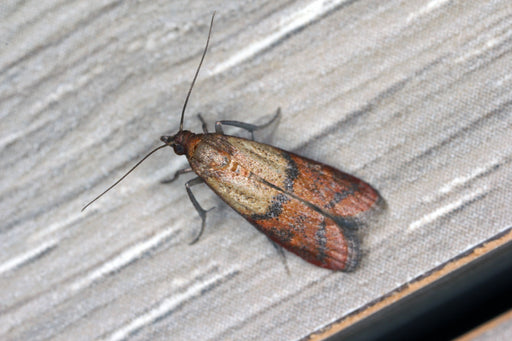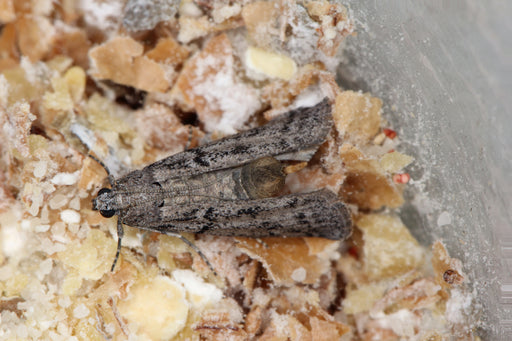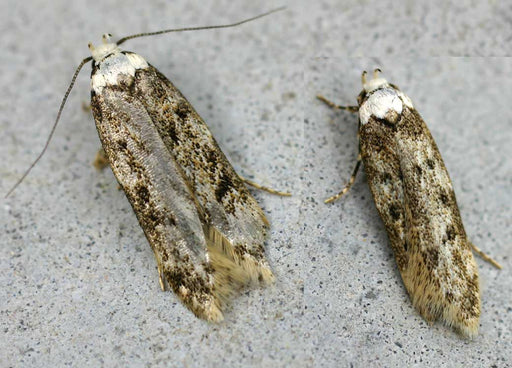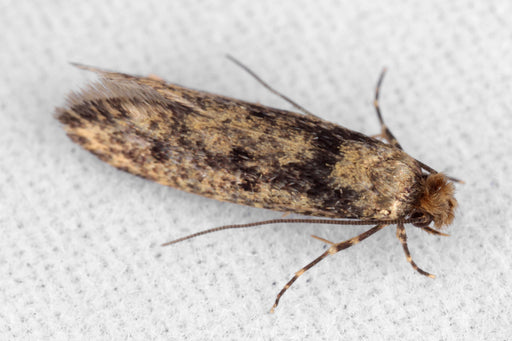Pantry Moth Pictures and Identification

Do you think your pantry has been invaded by grain-loving moths? If you have spotted small tan, brown, or gray winged insects fluttering about in a zigzag pattern, you may be dealing with pantry moths. There are four kinds of pantry moths to look out for in your kitchen: Indian Meal Moth, Mediterranean Pantry Moth, White-Shouldered House Moth, and the Brown House Moth.
Identifying which kind of pantry moth you have is essential to getting a targeted solution, further down we look at some pantry moth pictures.
What are Pantry Moths?
Pantry moths are also referred to as meal moths, because they will seek out and infest the grains and dried foods present in your pantry or cupboard. Pantry moths might look harmless at first glance, but don’t be deceived. The larva is destructive. Once hatched, the larvae will eat through food stores and leave excrement behind, spoiling food as they go.
Pantry moths attack a variety of products, from grains, cereal, beans, flour, dried fruit, animal food, chocolate, spices, herbs, candy, and animal-derived fibers, like wool.
Pantry Moth Pictures
Check out the pantry moth pictures and details below to help you identify which species is in your home.
Indian Meal Moth

The most common pantry moth around, Indian meal moths (Plodia interpunctella) are found around the world. The larvae are also known as waxworms.
Indian meal moths are 8-10 mm long and have a wingspan of 16-20mm wide. Unlike other pantry moths, this species has a small, bronze-colored head, bronze shoulders, and dark banding separating the yellowish top half of the wing from the reddish-brown on the bottom.
Mediterranean Pantry Moth

The Mediterranean pantry moth (Ephestia kuehniella), also known as a flour moth, is slightly larger in size (around 10-12mm long), and behaves much like the Indian meal moth. The adult moth has salt-and-pepper coloring that is broken up by a dark zigzag pattern. Legs and antennae are dirty white.
The easiest way to identify the Mediterranean flour moth is by the characteristic stance, known as the sloping pose. In this position, the moth is at rest and extends its forelegs while raising its head. No other pantry moth does this.
White-Shouldered House Moth
 Attribution: © entomart
Attribution: © entomart
A less common sight in homes, the white-shouldered house moth (Endrosis sarcitrella) has a breeding cycle that continues throughout the year. This moth is also attracted to light and is omnivorous. Though they are attracted to dry food, they also like wool.
Adult white-shouldered house moths are about 8-10 mm long and have light brown mottled wings with white around the head and shoulders. The larvae have a red head and whitish body.
Brown House Moth

Hofmannophila pseudospretella, or the brown house moth, is from the concealer moth family and thought to have originated in Asia. However, like most insects, the moth was introduced to other continents through human activity. Adult brown house moths are about 8-14mm long, with a wingspan of 15-26mm.
The defining features of the brown house moth make it easy to identify. These moths are largely light brown but have black or dark brown spotting on the wings. The edges of the wings are also dotted with dark markings. The larvae are about 6mm long, have brown heads, and off-white bodies.
Since brown house moths are scavengers, they will eat organic debris, oatmeal, flour, potatoes, bread, and even natural fibers in carpet and clothing. They are more destructive than the average pantry moth.
Final Thoughts
When you have pantry moths in your home, exercise caution! Tackle the issue before it becomes an infestation with pantry moth treatments specifically made for the kitchen. The first step in this process is to assess the moth presence in your home by placing Pantry Moth Traps around your kitchen, pantry and other food store areas. If you are finding a consistent or increased catch rate in your traps then you may like to read our Pantry Moths Kit Guide for information on how to use non toxic products in line with our Traps to rid your home of Pantry Moths.
About MothPrevention
MothPrevention® speak to customers every day about their clothes moth issues - clothes moths are a species that are ever increasing and that can cause significant damage to clothes, carpets and other home textiles.
To date, we’ve helped over 250,000 customers deal with their moth problems. We have developed professional grade solutions including proprietary pheromones and trap design, not available from anybody else in the USA.





